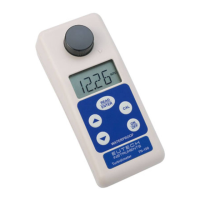Instruction Manual TN-100/ T-100
22
9.3 Degassing
Air or other trapped gases should be removed before measurement. Degassing is
recommended even if no bubbles are visible. There are three methods commonly
used for degassing:
Addition of a surfactant: This involves adding a surfactant to the water
samples to lower the surface tension of the water, thereby releasing
trapped gasses.
Application of a partial vacuum: Partial vacuum can be created by using
simple syringe or vacuum pump. (This is only recommended for ultra-low
turbidity measurement).
Use of an ultrasonic bath: This may be effective in severe conditions or
in viscous samples, but not recommended for ultra-low measurements.
Each of the method above has its own advantages and disadvantages. For
instance, under certain sample conditions, the use of vacuum pump or ultrasonic
bath may actually increase the presence of gas bubbles.
9.4 Timeliness of Sample
Samples should be measured immediately to prevent changes in particle
characteristics due to temperature and settling. Temperature can affect particles by
changing their behavior or creating new particles if precipitates are formed. Dilution
water may dissolve particles or change their characteristics. It is recommended to
take samples only when the turbidimeter is ready to be operated. Samples should
not be drawn and allowed to sit while the instrument warms up or is being readied.
9.5 Other Important Sampling Techniques
1. Samples should not be violently shaken or agitated as particles can be broken
apart or air may be entrapped into the fluid. Gentle agitation such as swirling the
sample vial is advisable to reduce particle settling.
2. Sample vials should be used only with the instruments for which they were
intended. Do not mix and match.
3. Perform a visual observation of the sample vial every time a measurement is
made. Ensure that there are no visible bubbles in the sample and the vial is
clean and free of scratches.
4. Samples entering the turbidimeter should be at the same temperature as the
process flow samples. Changes in temperature can cause precipitation of
soluble compounds and affect readings.
5. Sample vials should be evaluated with a low turbidity water (after cleaning) to
determine if cells remain matched. If the evaluation determines that a cell is
corrupted, discard the vial. It is recommended to conduct this evaluation weekly.
6. When in doubt or question about whether a sample vial is too scratched or
stained, throw it away.

